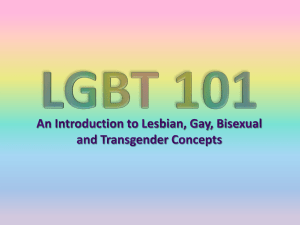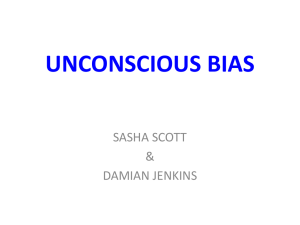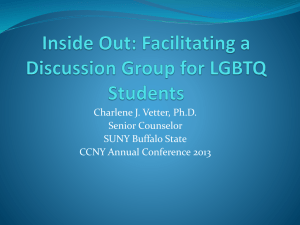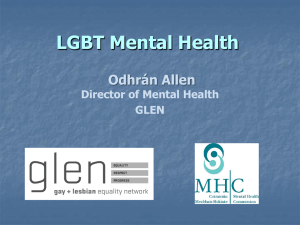GAY AFFIRMING COUNSELING Initiatives for Effective
advertisement
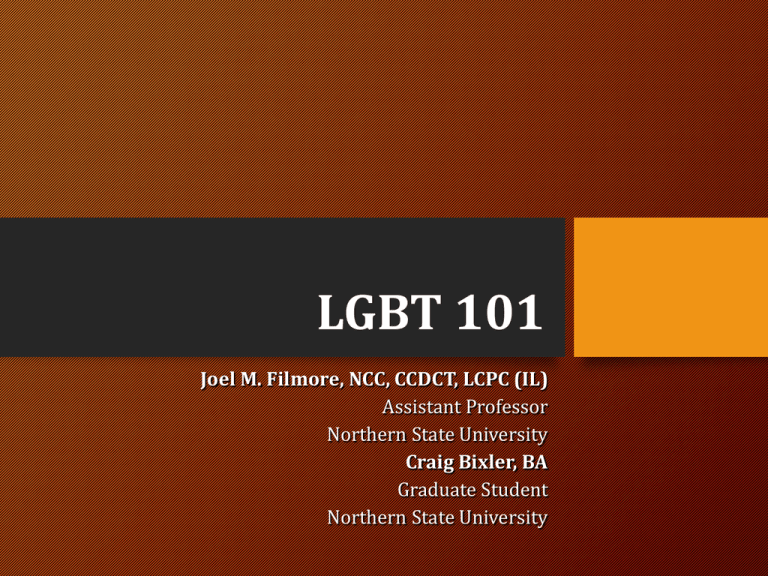
LGBT 101 Joel M. Filmore, NCC, CCDCT, LCPC (IL) Assistant Professor Northern State University Craig Bixler, BA Graduate Student Northern State University Gay–Affirmative Counseling Defined as: “Therapy that cerebrates and advocates the authenticity and integrity of Lesbian, Gay, and Bisexual (LGB) persons and their relationships” (Bieschke, McClanahan, Tozer, Grzegorek, & Park, 2000) Gay-Affirming Counselor Defined as: “One who views sexual minorities and LGB issues as central and identitydefining as opposed to marginal and perceived in terms of the heterosexual norms society holds” (Morrow, 2000) How does one become a Gay Affirmative Counselor/Therapist? McGeorge & Carlson (2011) indicate three steps: Step 1. Recognizing, and personal examination of, ones Heteronormative Assumptions, defined as “Automatic unconscious beliefs and expectations that reinforce heterosexuality and heterosexual relationships as the ideal norm” (p. 15) Reflection questions to gauge one’s heteronormative assumptions 1. What did my family of origin teach me about sexual orientation? Same-sex orientation? 2. What are my beliefs about how a person becomes gay, lesbian, bisexual, transgender? 3. What are my beliefs about why I did not become gay, lesbian, bisexual, transgender? 4. What would be my initial thoughts or feelings upon learning that an LGB person will be working as a teacher working closely with children? 5. When I meet someone, how often do I assume that he/she is heterosexual? What values and beliefs inform this assumption? How does one become a Gay Affirmative Counselor/Therapist? McGeorge & Carlson (2011) Step 2. Exploring Heterosexual Privileges (e.g. acknowledging the existence of heterosexual privilege and the ways in which [counselors] benefit from living in a heterosexist society). Reflection questions to explore heterosexual privileges 1. 2. 3. 4. 5. How has your involvement in heterosexual relationships been encouraged, rewarded, acknowledged and supported by family and friends? Have you ever had to defend your heterosexuality in order to gain acceptance among your peers or colleagues? Have you thought you might loose your job because of your heterosexuality? Have you ever feared that you would be physically harmed based solely on your heterosexuality? Do you worry that you will be denied visitation with your husband/wife, in the hospital, if either of you get sick? How does one become a Gay Affirmative Counselor/Therapist? McGeorge & Carlson (2011) Step 3. Exploring One’s Heterosexual Identity, i.e., becoming aware of the dominant socially sanctioned identities (e.g., White, male, heterosexual). Reflection questions to explore heterosexual identity 1. What societal beliefs or norms influenced the development of a heterosexual identity? 2. Do you understand your own heterosexual sexual orientation as a stable factor in your identity or do you perceive your sexual orientation as fluid and changeable, why? 3. How does your identification as a heterosexual influence how you make sense of how a person comes to identify as an LGB individual? 4. How does your identity as a heterosexual influence the way you do [counseling] with all your clients, regardless of their sexual orientation? Awareness, Knowledge, and Skills Granello (2004); • Don’t work with LGBT clients unless you are gay-affirming • Keep the client’s context at the forefront • Confront your internalized homophobia as a prerequisite to becoming gay-affirming • Send messages to clients that they are accepting of them as LGBT persons (do you have anything in your office that says you are “safe”?). • Be able to assess client issues related to his/her sexuality, issues that may be exacerbated by it, and issues that are not affected by it. • Be aware of local, regional, and national resources available for clients • Object to, and work toward, eliminating negative stereotyping of LGBT persons. Oppression • The use of power to deprive LGBT people of their human rights (i.e. parental, employment, survival benefits, etc.) and to unjustly exclude them from functioning “normally” as members of society. • Oppression is systematic and is maintained by the continuation, and repeated integration, of prejudice, power, and privilege into societal institutions (i.e. legal, religion, academia, and social). • Systematic oppression is present in any society where dominant and minority groups exists. • Oppression can be furtive or deliberate. Counseling and Language Usage • Language is extremely important and/or influential in all counseling relationships. Language identifies and names our lived experiences. It is cultural, shapes meaning, determines consciousness, and communicates worldviews of society members. • By identifying oppression as a system and by specifying oppressive practices (i.e. prejudicial acts) toward LGBT people, affirmative counselors are able to encourage and empower clients to fight against injustices. • The act of naming oppressive systems gives affirmative counselors the ability to recognize and attribute clients' emotions or inner conflicts regarding society’s negative attitudes, values, categories, and norms about sexual orientation. Coming Out The Coming Out Continuum • Coming out and living openly aren’t something you do once, or even for one year. It’s an ongoing journey that LGBT people make every single day of their lives. • Because of internalized homonegativity clients may present with extreme amounts of stress and depression which has its genesis in facing oppressive attitudes, rejection, and potential discrimination (Franke & Leary, 1991). Coming Out • Why is the Coming Out process ongoing? • How can I assist in the Coming Out process as a counselor? • What does the Coming Out process look like? • The first person your client has to be open with is themselves. • Look at the benefits and risks of coming out. • Make a coming out plan. • Start having the conversations. Coming Out Who: • Determine to whom the client is planning on coming out. • Explore the ramifications, potential outcomes, and pitfalls. Where: • Help your client decide where he or she will disclose, whether it’s in a letter, over the phone, or, preferably, in a quiet, private place. Coming Out Why: • Before disclosing, encourage client to explore why he/she is disclosing at this particular time. • Prepare your client for potential questions he/she may get asked. When: • Encourage your client not to disclose during an event or holiday. It is an important occasion, let it have the full attention it deserves. LGBT Youth Recognition that they are different • Confusion • Fear • Lack of understanding Others’ reactions • Rejection/Disappointment • Isolation • Stigmatization • Bullying, violence, and threats of violence At-Risk Issues for LGBT Youth • Family conflict • Lack of recognition, acknowledgment, or support • Feeling cheated and misunderstood • Guilt, shame, anxiety, self-blame and hate, and suicide The Parent’s Perspective • • • • • • • • • • • Disbelief, confusion, shame, embarrassment Lack of understanding Uncertainty about what to do Lack of knowledge about resources and support Lack of family, friend, and community acceptance Uninformed medical/psychology professionals Fear of making the wrong decision Social stigma Lack of school support Concern for child’s safety Adjustment to new future expectations for their child Supporting Your LGBT Youth • • • • • • • • • Acceptance Acknowledgment, respect, and love Professional support Expression of their gender Safety and protection “Normal” treatment by others Contact with peers School support Puberty-delaying hormones Simple Affirmative Techniques • Practice your inner Rogerian • Unconditional Positive Regard • Listen to their story. • Often times LGBT clients simply need to tell someone who they are, without judgment, and without being told who they are. • Ask questions for clarity. • Never worry that you will offend your gay client by asking questions. If they can answer, they will. • If you show your gay client that you are interested in getting to know them it will go a long way in developing the therapeutic alliance. Simple Affirmative Techniques • Don’t be afraid to admit you don’t know something about the culture. • Be prepared to educate (yourself and your client) • LGBT clients come to counseling with different levels of knowledge and understanding about the gay community. • You should have an understanding of the Gay Identity Models of development as this will help give you an idea of where your client is and how to best assist them. Simple Affirmative Techniques • Be Sensitive to Diversity • Often times when we talk about the “gay community” the inference is the “white” gay community yet within the Chicagoland area there are 3 major gay communities: the European-American, AfricanAmerican, and Hispanic-American gay communities. • All LGBT individuals are NOT alike. Research shows that with increased minority status comes additive and exponential mental health issues. • Ask your client to tell you how they, their family, and their culture, view homosexuality and don’t assume you already know. The More You Know… • • • • • • • • Community Resources HIV/AIDS Gay and Gray Substance Abuse Family Issues Abuse Domestic Violence Reparative/Conversion Therapy Counseling Today Online: No More Sitting on the Sidelines (Chaney, M., Filmore, J., Goodrich, K., 2011) References Biesche, K., McClananhan, M., Tozer, E. , Grzegorek, J., & Park, J. (2000). Programmatic research on the treatment of lesbian, gay, and bisexual clients: the past, the present, and the course for the future. In R. Perez, K. DeBord, & K. Bieschke (Eds.), Handbook of counseling and psychotherapy with lesbian, gay, and bisexual clients. Washington, DC: American Psychological Association. Capuzzi, D. & Gross, R. D. (2009). Introduction to the counseling profession. Columbus, Ohio: Pearson. Day-Vines, N. L., Wood, S. M., Grothaus, T., Craigen, L., Holman, A., Dotson-Blake, K., & Douglass, M. J.. (2007). Broaching the subjects of race, ethnicity, and culture during the counseling process. Journal of Counseling & Development, 85, 401-409. Dermer, S. B., Smith, S. D., & Barto, K. K. (2010). Identifying and correctly labeling sexual prejudice, discrimination, and oppression. Journal of Counseling & Development, 88, 325-331. Franke, R. & Leary, M. (1991). Surveying the intersection: Pathology, secrecy, and the discourses of racial and sexual identity. Journal of Homosexuality, 6(2-3), 1-19. Granello, D. (2004). Assisting beginning counselors in becoming gay affirmative: A workshop approach. Journal of Humanistic Counseling, Education and Development, 43, 50-64 McGeorge, C. & Carlson, T. (2011). Deconstructing heterosexism: Becoming an LGB affirmative heterosexual couple and family therapist. Journal of Marital and Family Therapy, 37, 14-26. Morrow, S. (2000). First do no harm: Therapist issues in psychotherapy with lesbians, gay, and bisexual clients. In R. Perez, K. DeBord, & K. Bieschke (Eds.), Handbook of counseling and psychotherapy with lesbian, gay, and bisexual clients. Washington, DC: American Psychological Association. Meyer, I. & Dean, L. (1998). Internalized homophobia in the therapist and gay or lesbian client: Conscious and unconscious collusions in self-hate. Psychotherapy, 30(1), 141-151.



